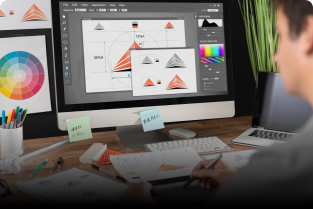Graphic design surrounds us in daily life—from the logos on your favorite brands to the layouts of websites and advertisements you encounter. But one question that often arises is: Is graphic design art? The answer lies in understanding the differences and overlaps between these two creative realms.
Defining Art and Graphic Design
Art is traditionally seen as a form of self-expression. Artists create to evoke emotions, provoke thoughts, or communicate personal or cultural stories. Its purpose is often open-ended, leaving interpretation up to the viewer.
Graphic Design, on the other hand, is a form of visual communication. Designers work to solve problems, convey specific messages, and guide audiences toward a goal, whether it’s buying a product, navigating a website, or understanding a concept.
Key Differences Between Art and Graphic Design
- Purpose and Intent
- Art: Focused on self-expression or storytelling, with no boundaries to its purpose.
- Graphic Design: Centered on communication, typically tied to a commercial or functional goal.
- Audience Engagement
- Art: Encourages interpretation; viewers decide what the work means to them.
- Graphic Design: Clear and direct; aims to deliver a specific message or solution.
- Creative Freedom
- Art: Boundless creativity, with no client or user constraints.
- Graphic Design: Creativity within guidelines, such as brand standards, audience needs, and project objectives.
- Medium and Tools
- Art: Often uses traditional tools like paint, canvas, and sculpture, but also explores digital formats.
- Graphic Design: Primarily digital, leveraging tools like Adobe Illustrator, Photoshop, and Figma.
How Graphic Design is Similar to Art
Despite their differences, graphic design and art share significant common ground:
- Aesthetic Value: Both prioritize visual appeal and creativity.
- Expression: Graphic designers often incorporate artistic elements to make their work unique and impactful.
- Cultural Impact: Both art and design shape and reflect cultural trends and values.
When Graphic Design Becomes Art
In some cases, graphic design transcends its functional roots and becomes a form of art. Examples include:
- Branding Icons: Logos like the Nike Swoosh or Apple’s logo have become cultural symbols beyond their original purpose.
- Poster Designs: Movie or music posters are often celebrated as pieces of art.
- Experimental Design: Designers who push creative boundaries may produce work that feels more like art than traditional design.
Why the Debate Matters
Understanding whether graphic design is art influences how we view the role of designers in society. While art thrives on individual expression, graphic design bridges creativity with utility. Recognizing this balance helps appreciate the skill and thought behind every design we interact with.
Final Thoughts
Graphic design is not art in the traditional sense, but it undoubtedly incorporates artistry. It exists at the intersection of creativity and practicality, solving problems while inspiring audiences. Whether creating a visually striking campaign or crafting a user-friendly app, graphic design demonstrates that functionality and beauty can coexist.
So, is graphic design art? The answer is nuanced—it is art when it transcends its purpose, but at its core, it is a powerful form of communication that borrows heavily from the principles of artistry.

